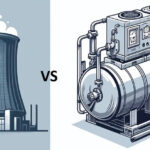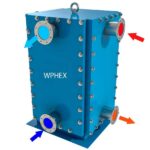Tube pitch in heat exchangers, This short article will answer some common questions on this topic.
Tube Pitch Definition
Tube pitch in heat exchangers is the shortest distance (Tube center to Tube center) between two adjacent tubes in a heat exchanger

Tube Pitch Arrangements
The main arrangement are, Square pitch (90 degrees), Rotated square pitch (45 degrees), Triangular pitch (30 degrees), and Rotated triangular pitch (60 degrees)
Arranged as shown below





Advantages and Disadvantages
Triangular or rotated triangular pitch accommodates more tubes than square or rotated square pitch
Below is a comparison between the arrangements
| Arrangement | Triangular Pitch | Square Pitch |
| Turbulence | Higher | Lower on shell side |
| Heat transfer coefficient | Higher | Lower |
| Pressure drop | Higher | Lower |
| Tubes arrangements | Accommodate more tubes | Accommodate less tubes |
| Heat transfer area | Lower | Higher |
| Number of tubes | Lower | Higher |
When boiling liquids are on the shell side, the square pitch arrangement allows vapours to rise thought the spaces between the tubes, this can prove more advantageous for this case over the rotated triangular pitch arrangement.
What about fouling?
Square pitch arrangement offers easier mechanical cleaning on the shell side having said that, this arrangement doesn’t produce much turbulence, this promotes greater fouling deposit rates.
When the Shell side Reynolds number are low (<2000) a rotated square pitch is better as a selected arrangement because it produces much higher turbulence. However, a Square or Rotated square pitch arrangement is used for heavily fouling fluids, where it is necessary to mechanically clean the outside of the tubes.
What are the recommended values for tube pitch?
Values for tube pitch is normally calculated based on the outer tube diameter. TEMA standards recommends a minimum tube pitch of 1.25 * Tube outer diameter for triangular pitch.
For example, if we have a tube outer diameter of 12.7 mm (0.5 inch) then the recommended tube pitch for triangular pitch arrangement is:
1.25 * 12.7 mm = 16 mm (0.6 inch).
For Square pitch, the recommended minimum clearance between the adjacent tubes for the ease of cleaning is 6.4 mm (0.25 inch). Thus, the minimum tube pitch is either 1.25 * Tube outer diameter or Tube outer diameter + 6.4 mm whichever is larger.
For example, if we have a tube outer diameter of 25.4 mm (1 inch) then the recommended tube pitch for square pitch arrangement is:
1.25 * 25.4 mm = 31.75 mm (1.25 inch)
In general, the minimum specified values of tube pitch are used in designs as they lead to smallest size shell for a given number of tubes. However, in some situations, the tube pitch maybe increased to a higher value to reduce shell side pressure drop in a cross-flow shell.
Common values used for tube pitch are 25 mm (1 inch), 30 mm (1.2 inch) and 38 mm (1.5 inch)
Why not increase the tube pitch to reduce pressure drop?
There is a couple of reasons for this,
- Increasing the tube pitch will result in increasing the Shell diameter for the heat exchanger, this will increase the equipment costs
- Its better to reduce the pressure drop by modifying the baffle spacing, baffle cut or shell type. This will result in cheaper design.
What is the recommended range of optimum tube pitch to tube diameter ratio for conversion of pressure drop to heat transfer?
In pressure drop – heat transfer relationships; higher turbulence is achieved at the expense of higher pressure drop. Increase turbulence increases the heat transfer rates. Typically, 1.25 – 1.35 for turbulent flow and around 1.4 for laminar flow.
References
K. S. N. Raju, Fluid mechanics, Heat transfer, and Mass transfer chemical engineering practice, AIChE, 2011, John Wiley & Son, Inc., Publication
Keywords; heat exchanger, tube pitch, triangular pitch, square pitch
Other articles that maybe or interest










